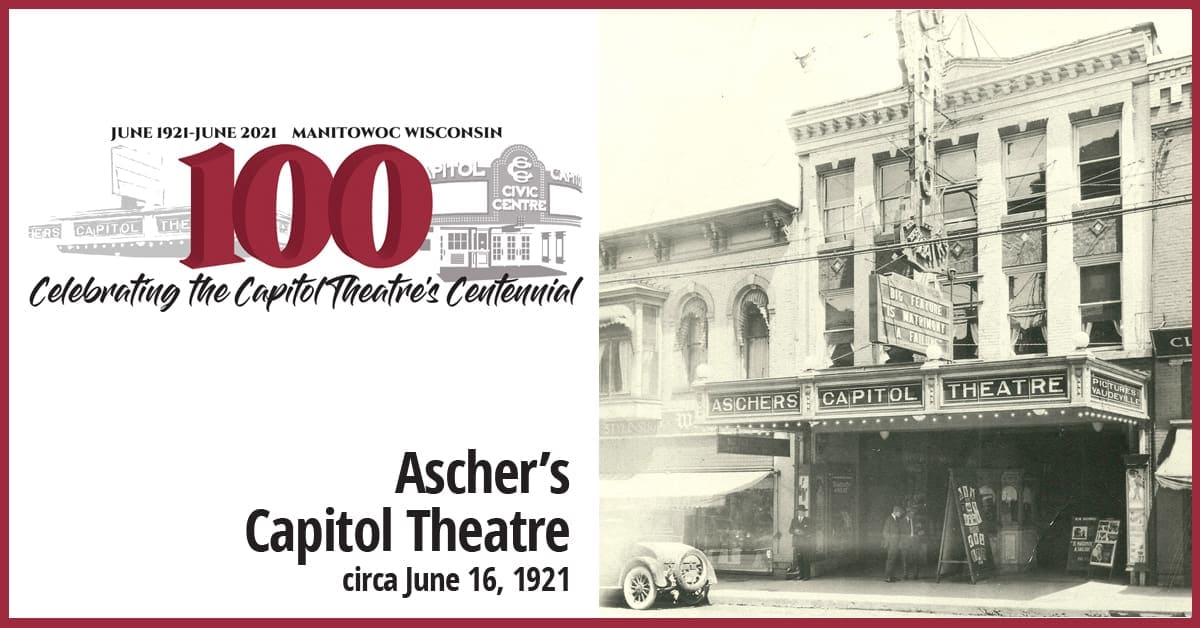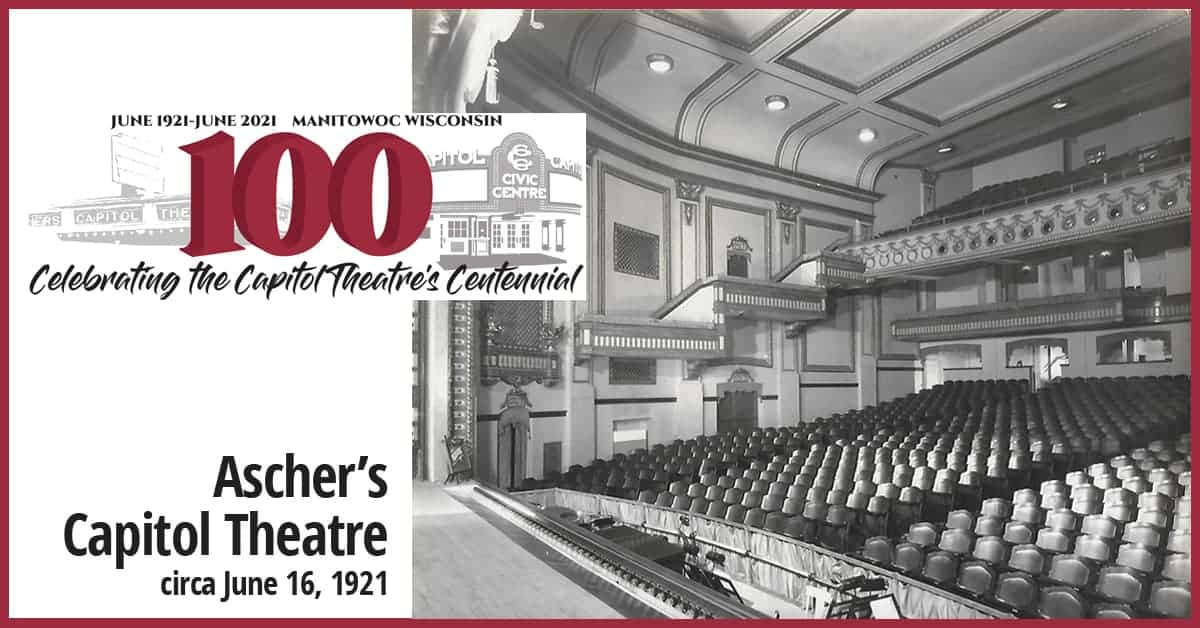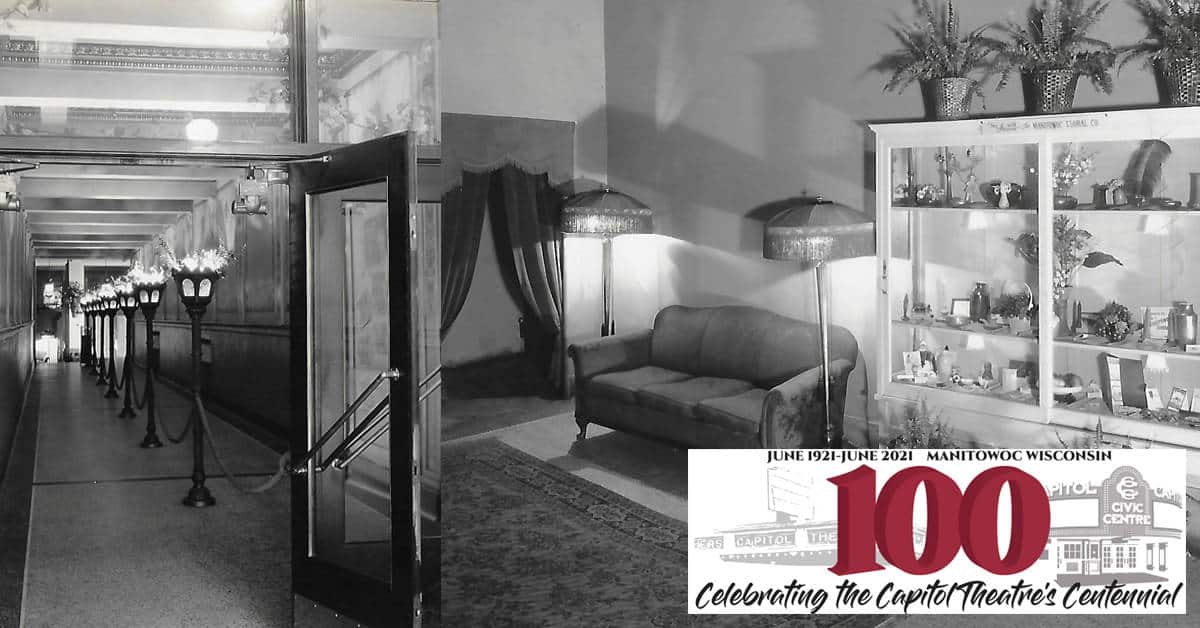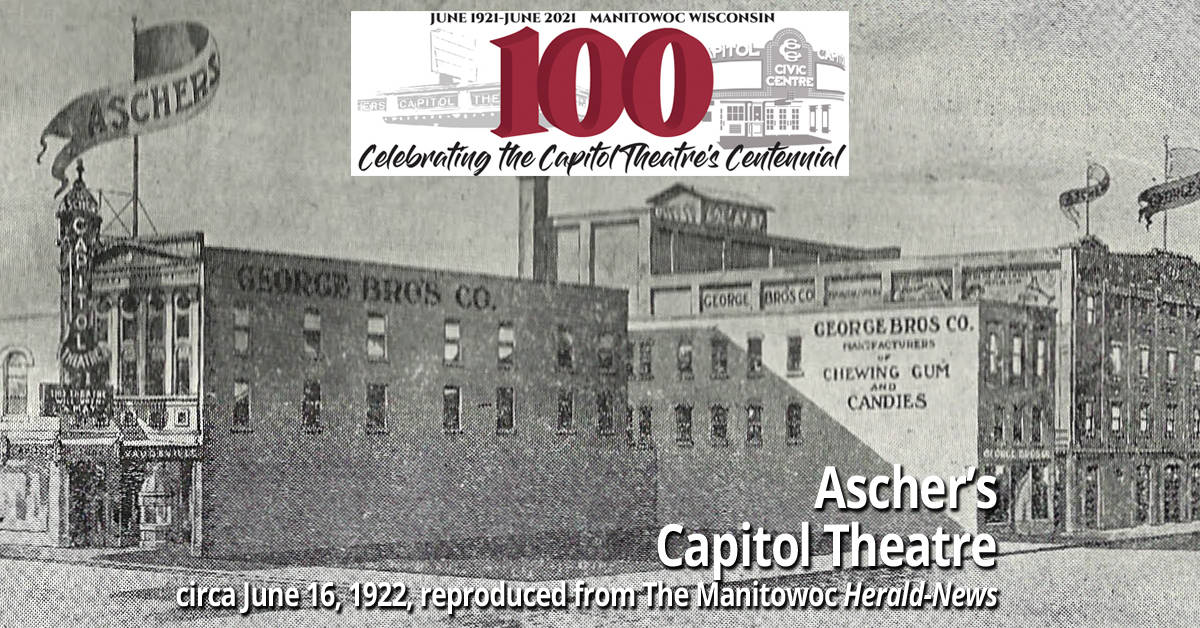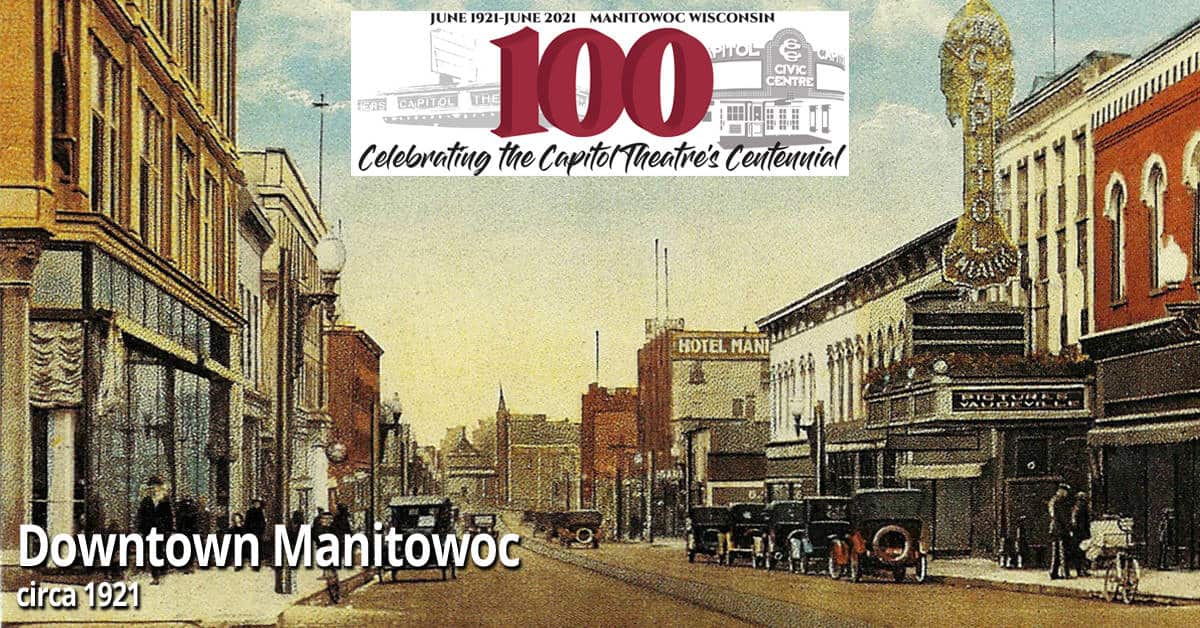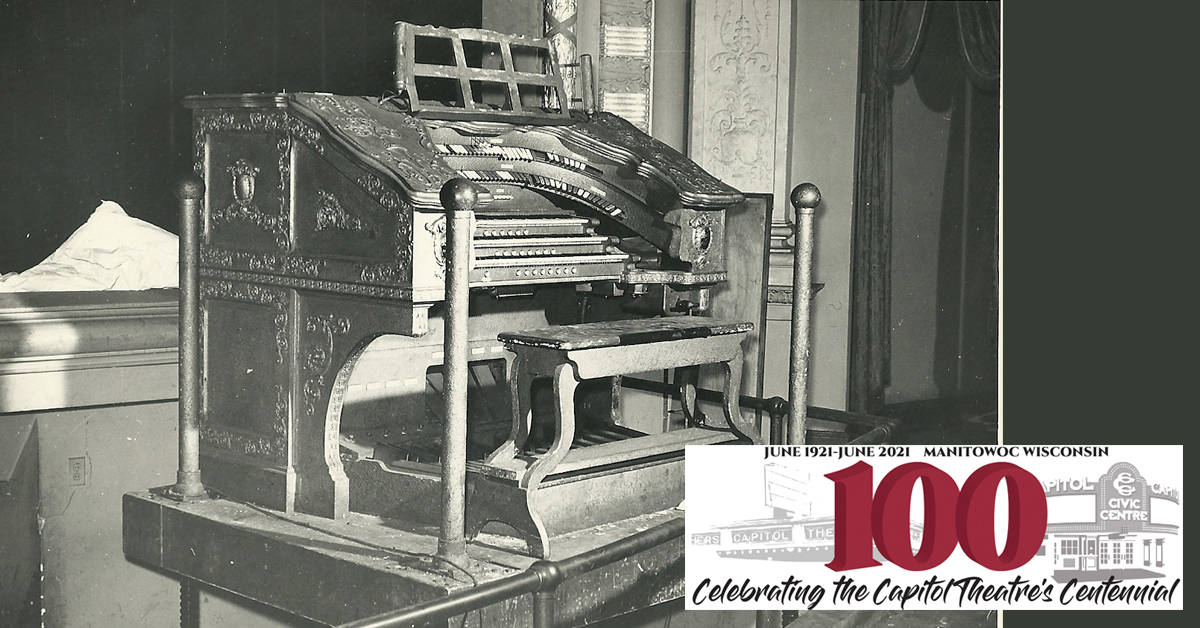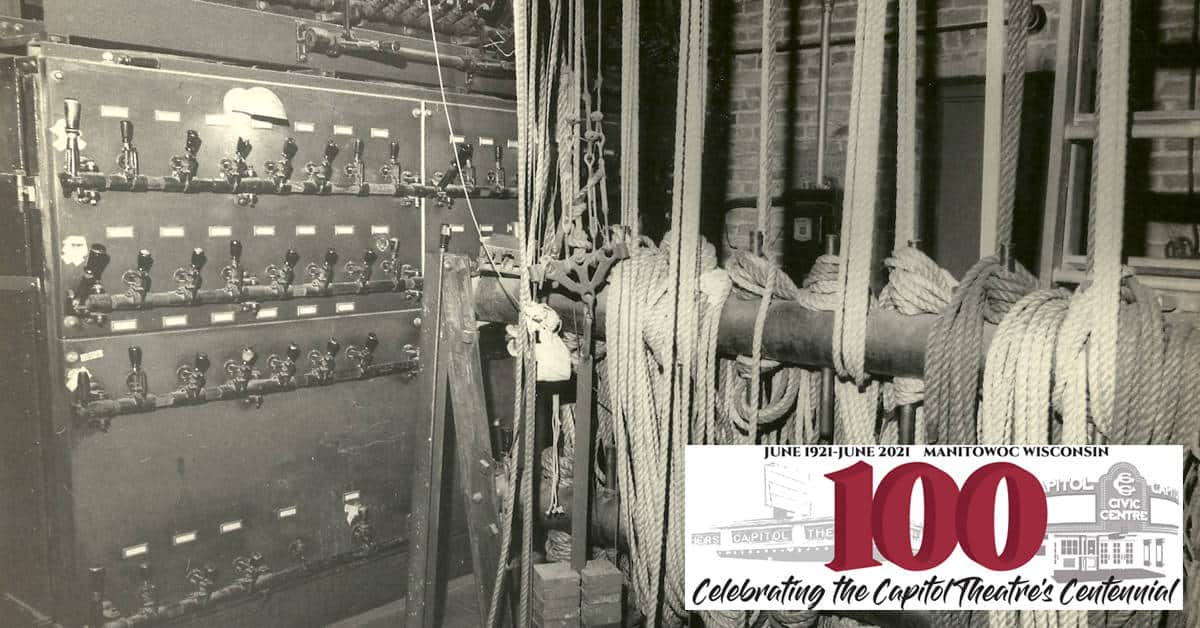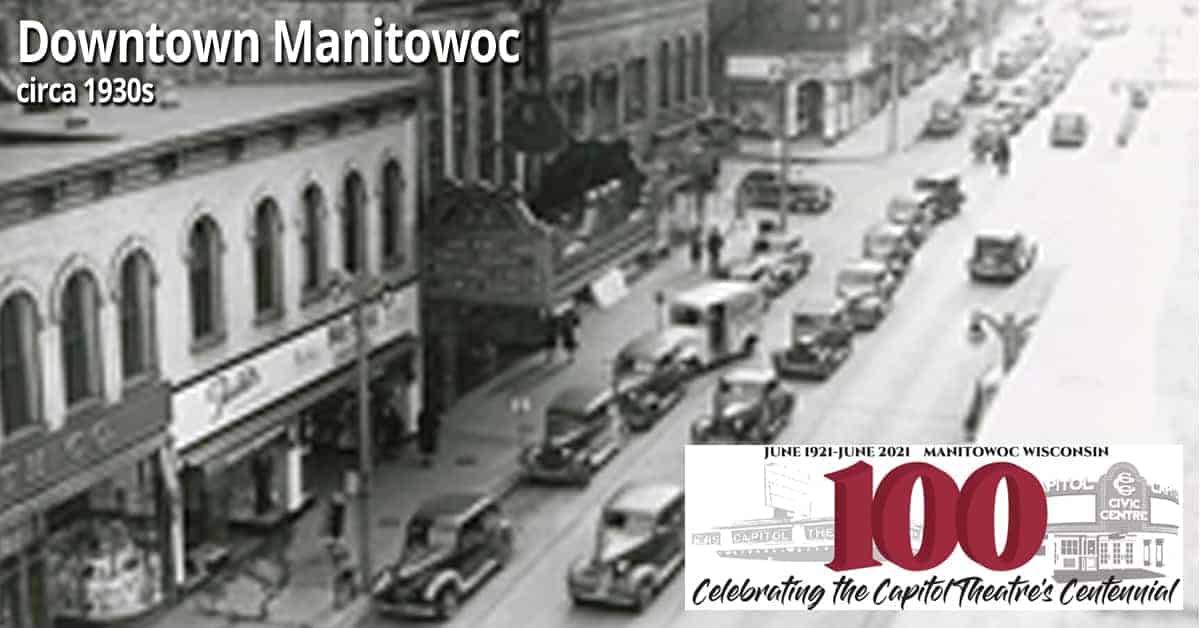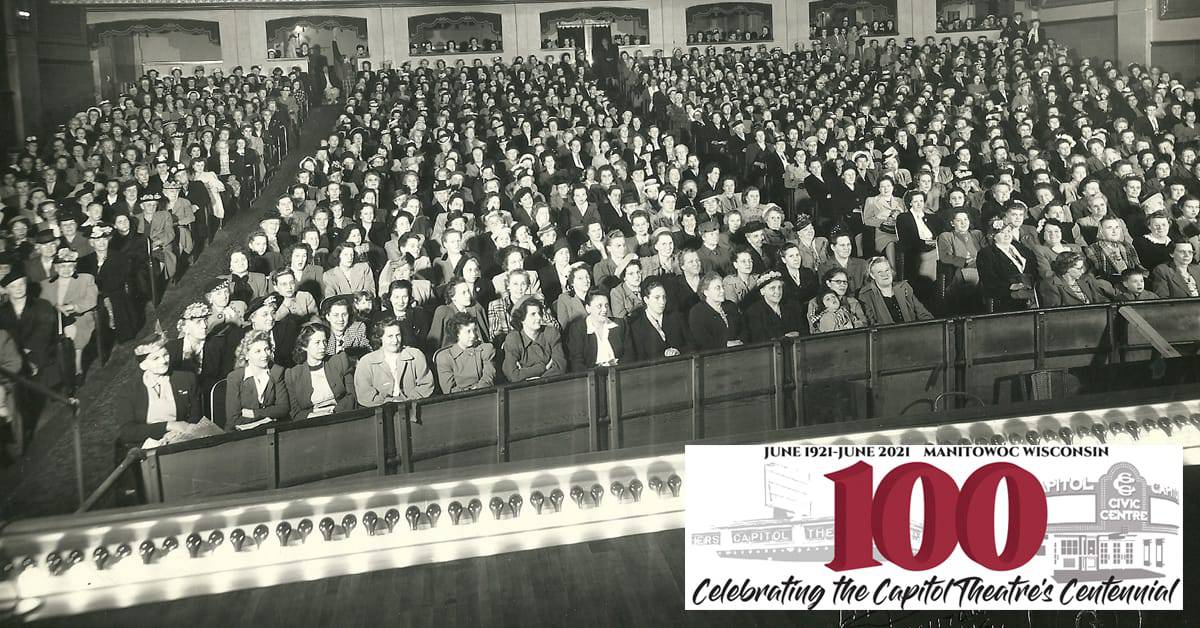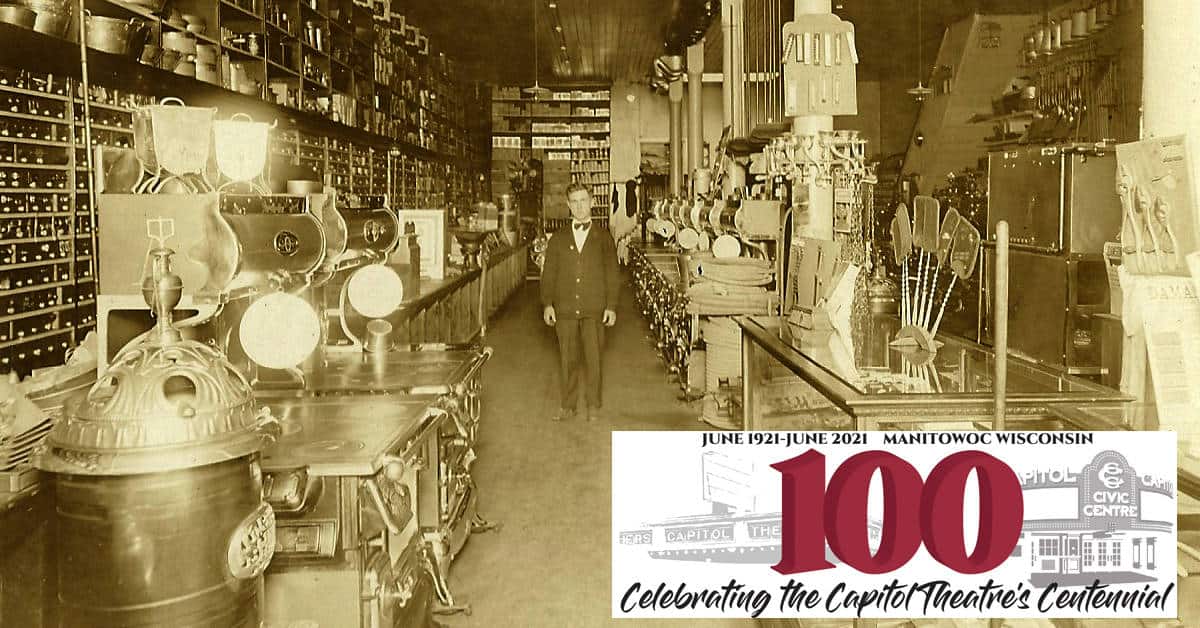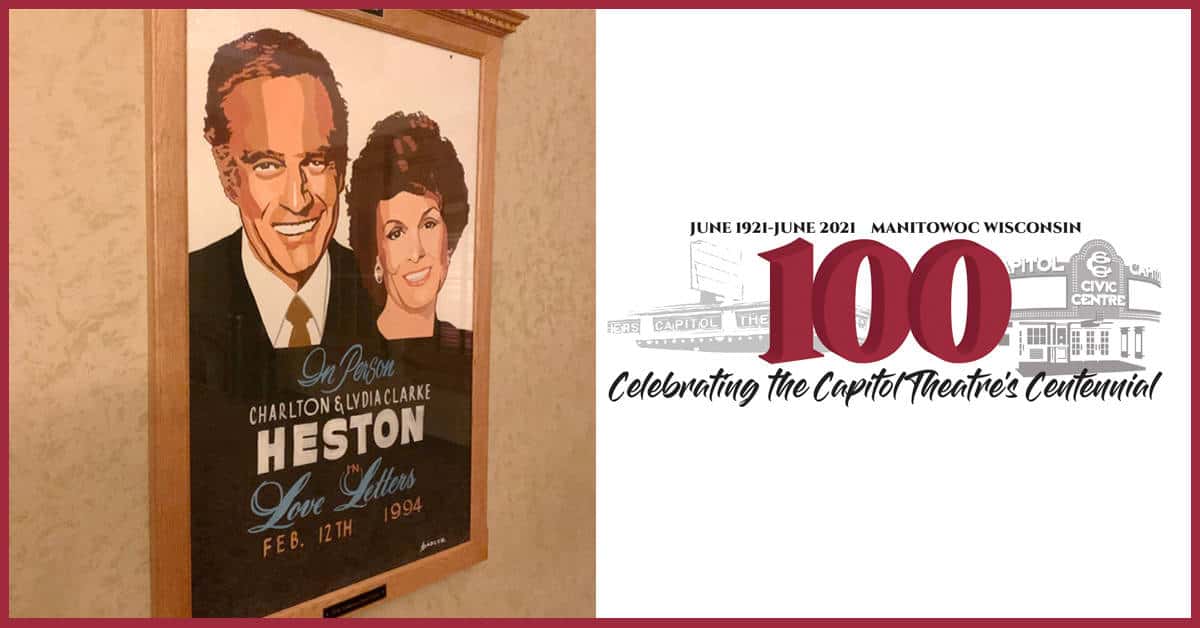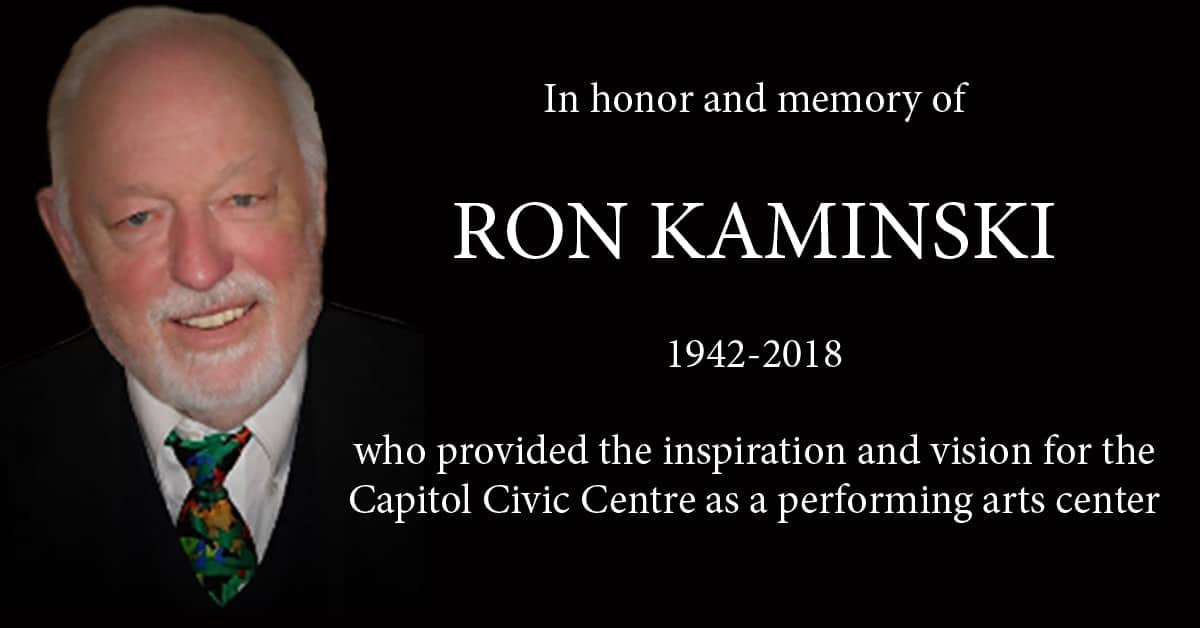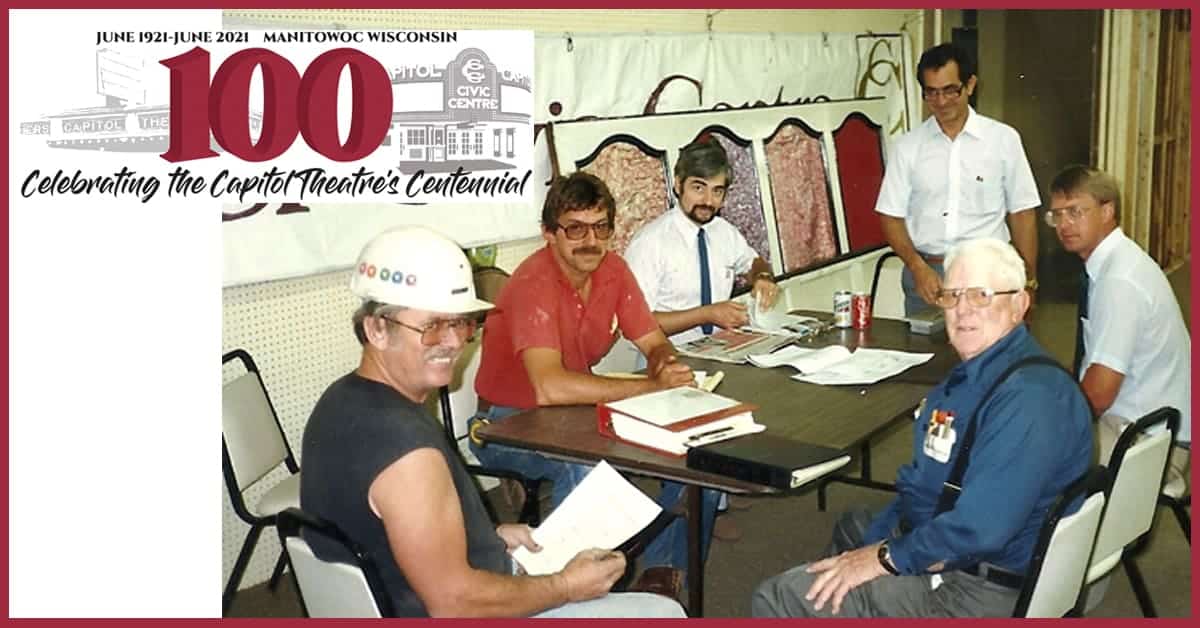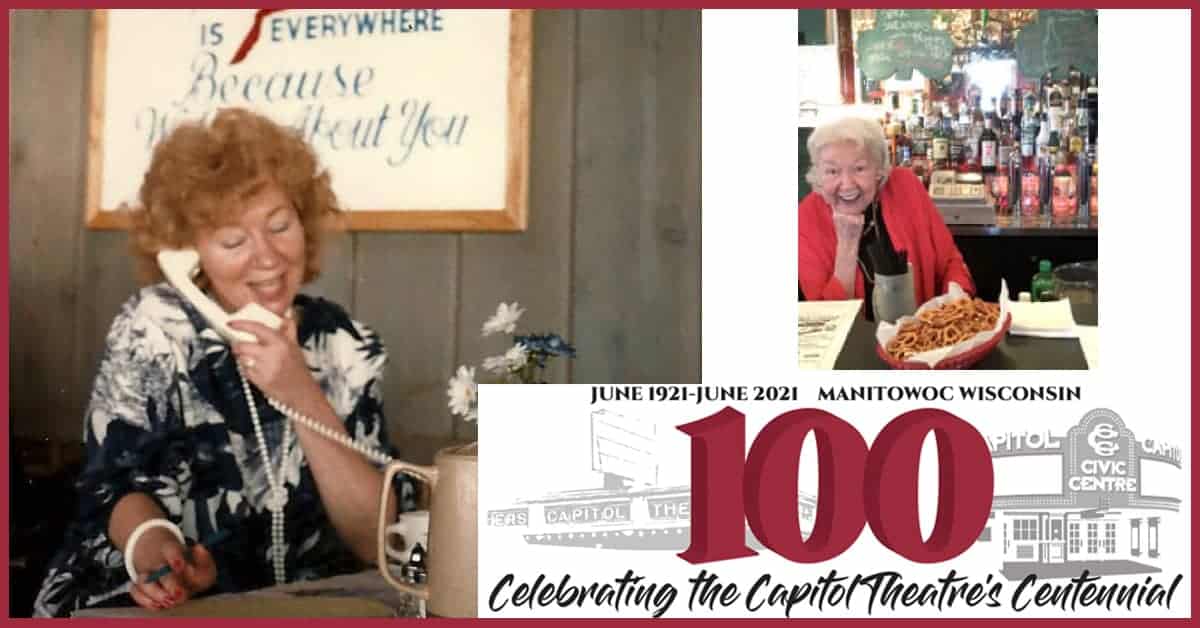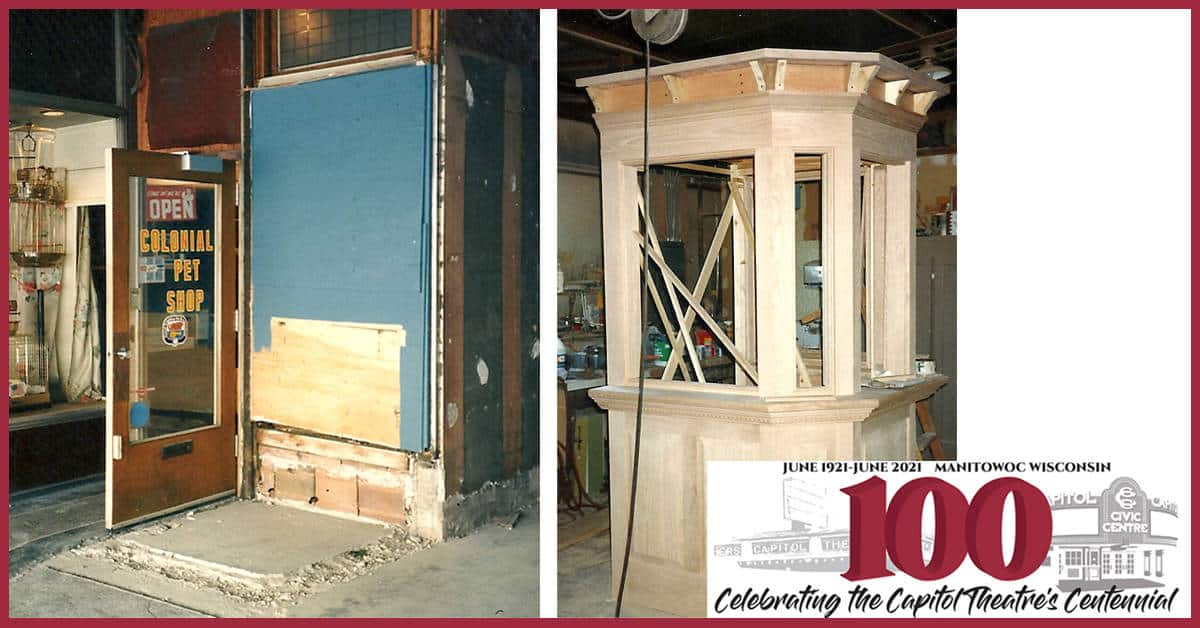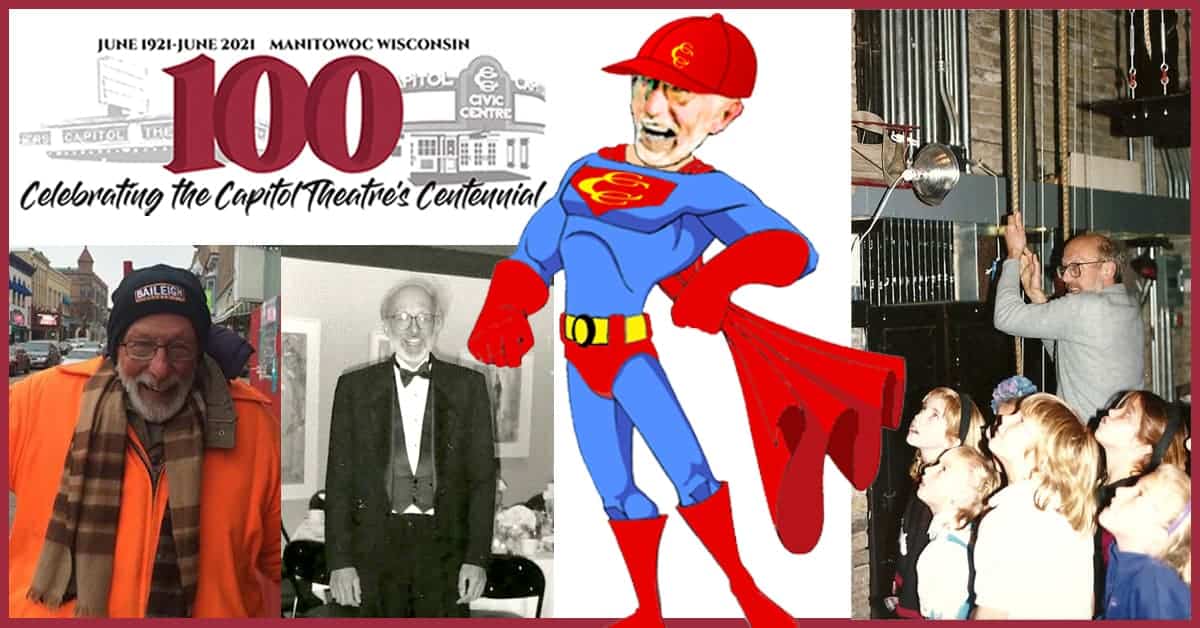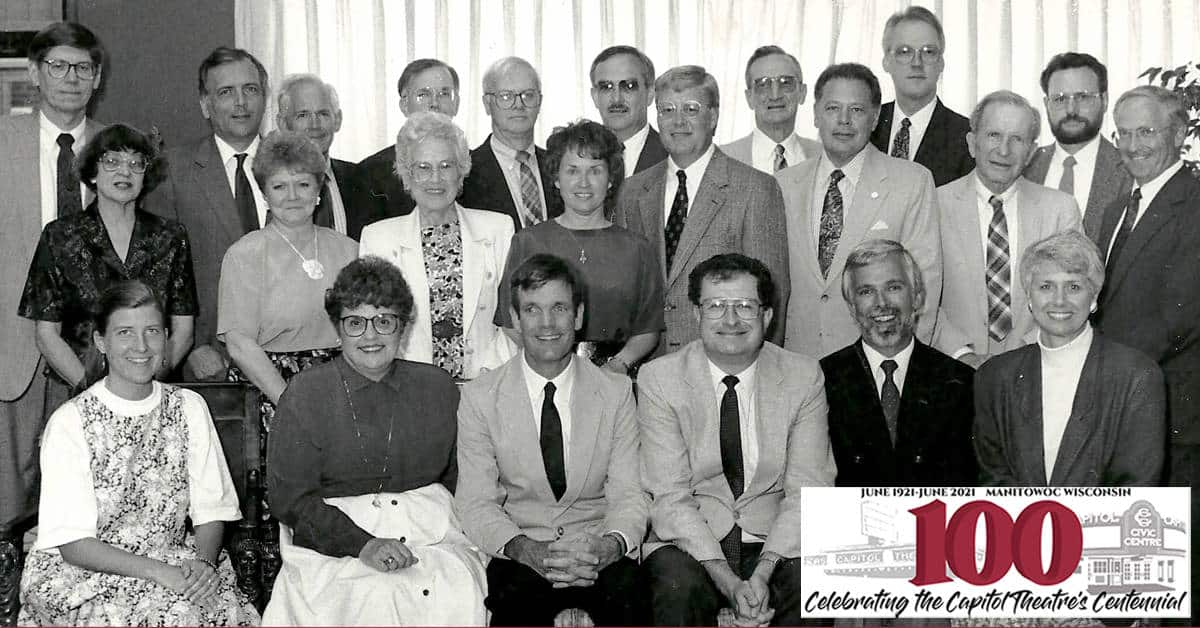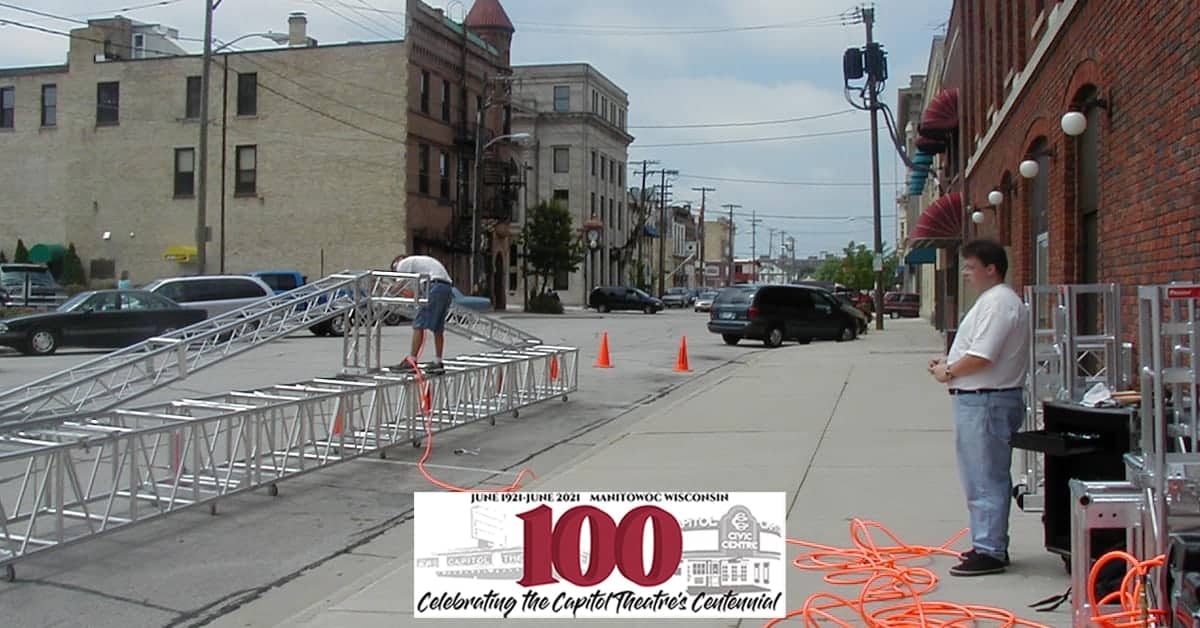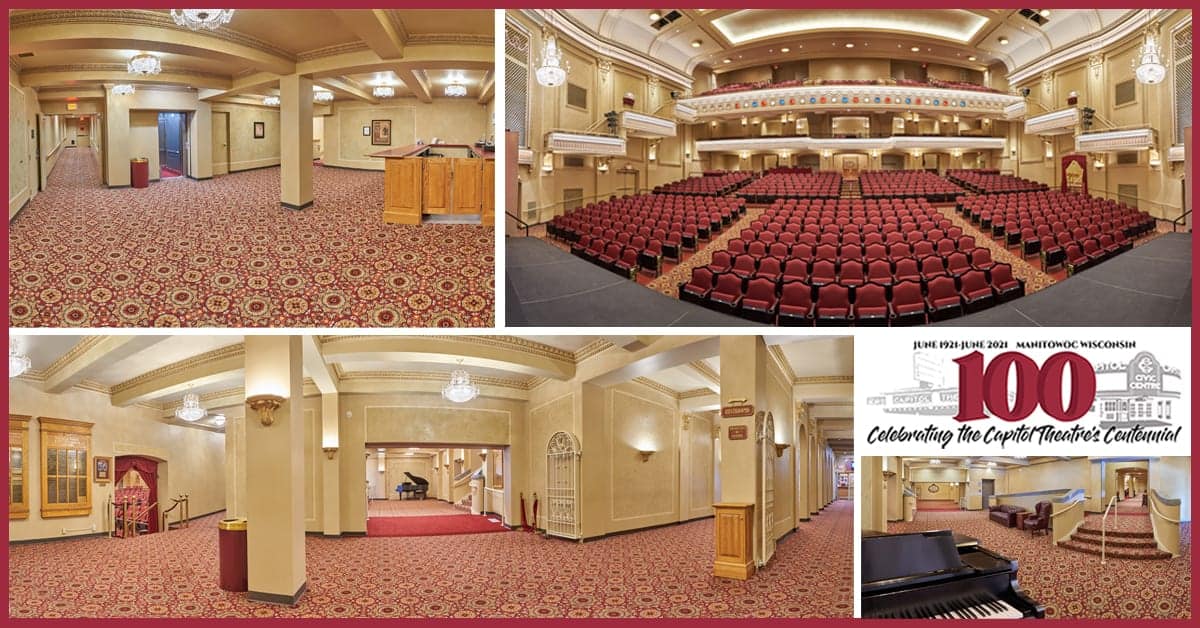Centennial Celebration
During the 100 days leading up to the centennial of the Capitol, a snippet of the Capitol’s history was shared with the community. Below is the summarized version of the celebration.
March 8, 2021: Let the Centennial Celebration begin! Join us as we commence a 100-day journey through the Capitol Theatre’s history. We’ll share historic details, bios from volunteers, tidbits about past performances, arts partners’ news, and more. We begin our 100-day Centennial Celebration splash today as a countdown to the iconic 100 Anniversary of the Capitol Theatre on June 16. Enjoy the ride and be sure to comment and share along the way.
March 9, 2021: Designed by local architect William J. Raueber and built by Arthur and John George of Manitowoc, construction of Ascher’s Capitol Theatre is complete and the theatre opens with a night of vaudeville, June 16, 1921. In early April 1921, the opening was predicted for May, but it did not take place until June 16.
March 10, 2021: The elegant theatre house, 1921. The Manitowoc Herald-News reported that the opening night of vaudeville entertainment, “The Review of the Times,” was a “notable offering of stellar lights” and that the theatre was a “bower of beauty.”
March 11, 2021: The elegant lobbies of Ascher’s Capitol Theatre are enjoyed by many in its opening season. Local residents were so eager to see the theatre built in Manitowoc that they subscribed to large numbers of seats for the opening performance for the then magnificent price of $10. “The Passion Flower,” starring Norma Talmadge, is the first celluloid flick presented at the Capitol; tickets were 11- and 25-cents (including war tax).
March 12, 2021: Ascher’s Capitol Theatre as is looked on its first birthday, June 16, 1922. The Manitowoc Herald-News reported on May 1, 1920, that local architect William J. Raueber had completed plans for a modern playhouse to be erected by the George Bros. Progress was slowed however when contractor’s bids exceeded estimates and the George Bros. had difficulties raising the necessary funds. In January 1921, community interest was further stirred when the Ascher Bros., the theatrical management firm to which the new theatre would be leased, announced it would book the Pantages vaudeville and first-run movies.
March 13, 2021: In the 1920s, downtown Manitowoc was a hub of hustle and bustle, and cars lined up in front of Ascher’s Capitol Theatre to purchase tickets for the latest in vaudeville entertainment.
March 14, 2021: Pictured is the stage display at Hotpoint Cooking School at the Capitol Theatre, April 1925 which was sponsored by Public Utilities Commission, Manitowoc. In the early days of electricity, the Utility took a lead role in promoting electrical appliances, thus the involvement in the Cooking School.
March 15, 2021: The Ascher’s Capitol Theatre organ lifted from the orchestra pit via a system of screws. A traditional organ console was not adequate to control a theatre organ—like the one pictured—as the large number of draw knobs required made the console so huge an organist could not possibly reach all of them while playing. Thus, the horseshoe console was born. Based on a curved French console design and using stop tabs instead of drawknobs, the horseshoe console allowed the organist to reach any stop or control while playing any piece of music, eliminating the need to move around awkwardly on the bench.
March 16, 2021: A historic peek behind the curtain at the original lighting panel and stage rigging. Presently, the lighting panel is on display near the concession stand on the first floor.
March 17, 2021: South Eighth Street is abuzz with traffic surrounding the Capitol Civic Centre in the 1930s.
March 18, 2021: A newspaper ad from Thursday, April 7, 1932, promotes Barbara Stanwyck and Frank Fay “direct from a tremendously successful tour of New York, Chicago, St. Louis, and Milwaukee.” The pair performed an original stage show with five performances at the Capitol on Sunday, April 10, 1932.
March 19, 2021: The Capitol Theatre house is packed with women (and a few children) for a war-time performance, circa 1939.
March 20, 2021: The Manitowoc Herald-Times became host of the long-standing Cooking School and in 1940, Edna Ferguson showcased her culinary skill and the latest in appliances, bakeware, and cookware to four consecutive packed houses. The Capitol was home to the Cooking School until 2015.
March 21, 2021: For the first time since it was built, the Capitol had a sell-out in August of 1943 for the Army emergency relief effort, bringing in $3,232.
March 22, 2021: Throughout the years, the Capitol has been a hub for entertainment, making memories for nearly 100 years. Pictured is a classic example of a ticket from 1944.
March 23, 2021: What is now The Mertens Lounge, directly south of the main entrance under the marquee, was once home of Teighten Hardware. Later, the site would be home to a clothing store, book store, and music store. The Society to Preserve the Capitol purchased this building during the 1986-87 renovation. Presently, this area adjacent to the Salutz Family Lobbies features The Cawley Company Bar and houses first-floor concessions at the Capitol.
March 24, 2021: The Capitol is one of only 150 theaters in the nation to be chosen to show the history of the Girl Scouts movie “Women of tomorrow” in March of 1950.
March 25, 2021: A view from the house to the stage from the 1950s. The house seating has changed and improved significantly over the years, including most recently with the Act Two renovations. During the 1986-87 renovations, the carpet was replicated and installed and this vibrant and durable carpet remains an iconic feature of the auditorium today.
March 26, 2021: Nationally-known barbershop quartets The Mills Brothers and Two Rivers’ own Schmitt Brothers meet at the Capitol in April of 1952. The talented Schmitt Brothers—Jim, Joe, Paul, and Fran—grew up in a family of 17 and learned to sing in the church choir. They won the 1951 Society for the Preservation and Encouragement of Barber Shop Quartet Singing in America title. Published last year, the novel “The Schmitt Brothers” tells the story of the brothers.
March 27, 2021: In September of 1955, Charlton and Lydia Clarke Heston attended a show at the Capitol. The visit was a home-coming of sorts for Lydia, who was born and raised in Two Rivers. In 1994, the Hestons returned to the Capitol, this time to star in the play “Love Letters.” This original show poster by Joe Zabler from their Feb. 12, 1994 performance hangs in the lobby of the Capitol.
March 28, 2021: Pictured is the circa 1964 movie theatre staff in the lobby of the then-recently remodeled Capitol Movie Theatre. Please note that today’s Capitol staff attire is a tad less formal.
March 29, 2021: Enjoy a view of the lobby corridor during the Capitol’s final year as a movie theatre—circa 1986—featuring a poster of Eddie Murphy in “The Golden Child.”
March 30, 2021: The Masquers, Inc. purchased an option to acquire the Capitol from Manitowoc Theatre Corporation in April of 1982 and contract with Conrad Schmitt Studios, Inc. of New Berlin, Wis. to explore restoring and decorating the Capitol. Later, they hired American City Bureau to complete a financial feasibility study to determine local support for the project. The City of Manitowoc approved use of Tax Incremental Funding to restore the Capitol.
March 31, 2021: The Masquers option to acquire the Capitol Theatre expires and Marcus Corporation purchases the theatre in September of 1985.
April 1, 2021: Articles of Incorporation of the Society to Preserve the Capitol, Inc. are approved by the State of Wisconsin in May of 1986.
April 2, 2021: Today we honor Ron Kaminski who inspired the vision to renovate the Capitol Theatre, turning it into a venue for live performing arts. The Society to Preserve the Capitol, Inc., a private, non-profit corporation purchased the Capitol from the Marcus Corporation for $250,000 in January of 1987. Lead gifts of $50,000 each are made by The Masquers, Inc. and Mrs. Helen Schuette. Kaminski is Chairman of the Board and Craig Pauly is the first Board President. Ron had said that the Capitol “stands as a monument to the idea that large goals are still achievable by people acting in unison for a common goal.”
April 3, 2021: Today we recognize Craig Pauly, the first Capitol Board President. Craig is a remarkable leader in the Capitol’s history, having served many years on the Capitol Board of Directors and the Capitol Foundation Board, as well as numerous committees. Additionally, he and Cindy have been long-standing Capitol patrons, donors, and members—most recently becoming Centennial Society members. Thank you—Craig and Cindy—for your dedication to the Capitol!
April 4, 2021: Ron Kaminski—who had the courage and tenacity to act on a dream of the Capitol as a performing arts center—is shown working into the wee hours of the evening in what is now a dressing room area, under the stage.
April 5, 2021: “The Final Curtain”—a benefit show by local performers—closes the old Capitol Theatre in June of 1987. Soon after, the work to create a performing arts venue begins.
April 6, 2021: Local professional trades and volunteers discuss renovations in 1987. Standing is Gene Maloney and seated to his immediate right, Steve Hamann—both whom continue to support the Capitol today. Most recently, Gene and Steve were instrumental in the success of the “Act Two” renovations. Chief improvements are new auditorium seating; enhanced flow amongst first-floor lobbies, concessions, and the theater; elevator and stair access to the second-floor lobby—featuring concessions, restroom suites, and convenient mezzanine entry.
April 7, 2021: Original Board members gather in the lobby of the Capitol Theatre (then a movie house) to discuss plans for renovations.
April 8, 2021: Jerome Dick, first co-Vice President of the Capitol Board, was an intrepid leader in fundraising for the 1986-87 campaign to renovate the theatre. Jerry, who passed away in September of 2011, is photographed here representing the campaign. Remember Dick Bros. Bakery and Memories the Gift Shoppe…these, too, flourished with Jerry’s involvement.
April 9, 2021: Ron Kaminski led countless tours (like the one pictured here) of the Capitol property during the campaign and renovations. Pictured is a work-in-progress by volunteers and trades, circa 1987.
April 10, 2021: Kathie Bundy, long-time owner of Kathie’s Stage Door Pub, local radio personality, and enthusiast of everything Irish, is pictured soliciting donations for the Capitol Theatre renovations. Kathie, who passed away in June of 2019, was fondly known as a talented actress and producer/director of many shows, including “A Christmas Carol.” She also was a fantastic storyteller of Capitol spirits, who many believe “reside” at the Capitol today.
April 11, 2021: Professional trades and volunteers accomplished monumental feats over the course of the 1987 renovations. With the vision of the planning team, one notable task was creating this opening from the lobby to the theatre house.
April 12, 2021: Lee Kummer, first co-Vice President of the Capitol Board is pictured in the Capitol lobby with his wife Eileen (circa 1987). Through the years, Lee has served as Board president, on the Capitol Foundation Board, and was greatly involved in Board and committee work at the Capitol. We sincerely appreciate Lee and Eileen’s long standing support of the Capitol—as members, donors, and patrons.
April 13, 2021: The ticket booth—which presently abuts the box office—was replicated during the 1987 renovation. While it no longer is used for selling tickets, it’s a nostalgic nod to the past and the perfect place to display a vintage Christmas tree for the holidays.
April 14, 2021: George Reis (right)—first Treasurer of the Board—is pictured with original Board member Don Seehafer, and 1989-1991 Board member Dolly Stokes, in this circa 1990 photo.
April 15, 2021: During the course of the 1987 renovation, professional trades and volunteer crews tackled the daunting task of repairing plaster and architectural detail (the state of which is pictured here, prior to renovations) throughout the theatre. Working long hours, many during the evenings and weekends, the stunning auditorium that we enjoy today—34 years later—is a testament to their dedication and skill.
April 16, 2021: Folks could purchase raffle tickets ($20 each) to win this classic 1970 Ford Torino GT convertible. Donated by original Board member Don Gadzinski, the drawing to win the Torino took place at “The Curtain Rises” festivities.
April 17, 2021: In 1987, original Board member Leo Touhey (pictured at the Capitol with wife Loris) organized a volunteer crew who worked endlessly to keep costs to a minimum. At that time, the Capitol Times newsletter acknowledged the work of Cory Krueger and Ron Keith—who worked full-time hours for several months—as well as Jim Brogan, who worked at the Capitol immediately following his full-time job elsewhere. Volunteer crews worked alongside the general contractor—Hamann Construction Company—and Conrad Schmitt Studios, who oversaw the renovation.
April 18, 2021: Fundraising Chair, Jerry Dick, was granted a paid leave of absence from his job at Richter Vinegar to lead the $1.5 million 1987 campaign. In addition to monetary funds, numerous local and regional individuals and companies provided in-kind donations. The community kept close tabs on the steady progress of the campaign with indicators such as this “thermometer” at First National Bank (now Bank First) on Eighth Street.
April 19, 2021: Work continues in 1987. Pictured is a crew member jackhammering access from stage left, which required removing several layers of brick. What an arm workout!
April 20, 2021: Folks traveling Eighth Street in 1987 are reminded of the Capitol renovation campaign, while the marquee calls for volunteers.
April 21, 2021: In addition to creating access from the lobby to the auditorium and from stage left to the original loading dock off the Jay Street alley (burgundy doors, pictured here), access was also created at two points off the main floor from the auditorium to the alley. Pictured is a crew member framing one of these exits.
April 22, 2021: When purchased from the Marcus Corporation, cast marquee letters and numbers were stored on shelf units on the Capitol stage. Volunteers immediately dove into clearing these items and more, as well as cleaning the facilities (including scraping dried bubble gum, several inches thick, from the auditorium floor).
April 23, 2021: A view of the east staircase to the mezzanine level, pre-1987 renovation, and the west staircase with renovation underway. In addition to these original staircases, presently—post-Act Two renovations—patrons are able to access the mezzanine (and subsequent balcony level) via a staircase and elevator located off the Salutz Family Lobby (which was previously the pub).
April 24, 2021: Stunning stained glass light fixtures can be admired at the Capitol. During the Act Two renovation, Dr. John and Laurale Stern provided the funding for reproduction sconces to complement those pictured here. You will find the beautiful sconces along the stairwells at the rear of the house, providing ambiance as they light the way to the upper levels.
April 25, 2021: This 100-day journey—offering a sampling of the Capitol’s history—is made infinitely better with the work of Judie Stuntz, who cataloged information and photos from prior to the grand opening 1987 season through the late 1990s. Judie’s well-organized binders tell the story of acquiring the Capitol Theatre; the amazing feat of professional trades and volunteers to restore the auditorium, dressing rooms, lobbies, and entrance in a matter of months; and the first decade of the Capitol as a center for performing arts. The author of these posts is indebted to Judie’s attention to detail! Judie—pictured at work in 1992 at the Capitol—preserved hundreds of photos, archived newsletters, and print articles, and provided the background for a story that we simply would not be able to properly tell without her dedication. Our thanks to Judie for her devotion to providing this rich history, which we sincerely treasure.
April 26, 2021: Conrad Schmitt Studios, New Berlin, Wis. (which oversaw the renovations) worked from an elaborate system of scaffolding in the auditorium to remove architectural detail for reproduction, repair plaster, and apply finishes—beautifully restoring the Capitol.
April 27, 2021: A renovation crew member is pictured bolting seat arms to the auditorium floor. Note that one of the two stunning chandeliers (crated in the background) is awaiting assembly and installation. It is reported that two volunteers worked with gloved fingers for days hanging the crystals on the chandeliers, which remain amongst the most-admired assets of the Capitol’s décor.
April 28, 2021: Amazing restoration was completed during renovations. Architectural detail was removed, replicated, and restored. The attention to detail and dedication to the craft is evident and is clearly a labor of love and lasting source of pride.
April 29, 2021: Shortly after trades and volunteers begin renovations, what was then House of Paperbacks—just south of the marquee—was purchased in 1987, thereby expanding the Capitol’s footprint. Thereafter, property on Franklin Street was purchased, allowing room for future parking.
April 30, 2021: A glimpse from the lobby corridor ramp opening to the headquarters for renovations meetings, located in what was House of Paperbacks. This large space is now known as The Mertens Lounge and features The Cawley Company Bar.
May 1, 2021: The box office, under construction here adjacent to the lobby corridor, initially faced north (toward coat check). The first floor lobby is now known as The Salutz Family Lobby.
May 2, 2021: The movie house marquee is removed and framework for the new marquee is in place. Finally, the new Capitol Civic Centre marquee is aglow at dusk!
May 3, 2021: The Ruth St. John and John Dunham West Foundation has provided extraordinary support to the Capitol Civic Centre. The theater, officially known as The West Auditorium, is acknowledged with a plaque (pictured here) displayed adjacent to the main floor entrance. In addition to the major support provided by the West Foundation during the 1986-87 campaign, generous funding has been consistently provided to subsequent renovation campaigns, the Capitol Civic Centre Foundation, and Capitol operations. Additionally, the West Foundation provides the funding for the Student Adventure Series, attended by hundreds of area elementary school students annually since 1997. We are sincerely grateful for the West Foundation’s longstanding support of the Capitol!
May 4, 2021: In 1987, Lillian Kadow donated a painting of her late husband, Francis Kadow, as well as a select collection of photos autographed by stars of film, television, and stage. Francis, who passed away in 1973, owned and operated the Mikadow Theater and the radio station WOMT. The call letters “WOMT” stood for “World’s Only Mikadow Theater” with the station going live in 1926, broadcasting news every hour on the hour. News was taken largely from the United Press wire service teletype, the first one installed at a radio station. WOMT was purchased in 1970 by the late Don Seehafer, an original member of the Capitol Civic Centre Board of Directors and long-standing supporter of the Capitol. Following Lillian’s death in 2009, her estate made a second generous gift to the photo collection held by the Capitol. The collection is proudly displayed in the Salutz Lobby II for all to view.
May 5, 2021: People flock to the Capitol Civic Centre on Oct. 30, 1987, to attend “The Curtain Rises,” a variety show featuring local talent—including the harmonious sound of the Clipper City Chordsmen—pictured on stage. The following day features a show with family appeal. The Capitol Civic Centre is open after months of renovation, providing a venue for local arts organizations as well as the stage for a season featuring touring performances, initially known as the “Lively Arts Series.”
May 6, 2021: The Manitowoc Symphony Orchestra’s first performance at the Capitol Civic Centre is Nov. 1, 1987. They are joined by the US Army Jazz Band. Manitowoc is the smallest city in Wisconsin to have its own symphony and much is due to the credit of its first conductor, Karl Miller. Manuel Prestamo served as the next conductor, from 1986 to 1990. The orchestra’s 40th season welcomed music director, Wayne Wildman, whose education and vast accomplishments contributed greatly to the growth of the MSO. Wayne stepped down from the podium after 29 years, handing his baton to Dylan Thomas Chmura-Moore (pictured conducting the orchestra) after the 2018-2019 season.
May 7, 2021: In 1931 a group from Manitowoc formed an amateur dramatic society known as the Manitowoc Masquers. After merging with another group from Two Rivers, they changed their name to the Lakeshore Masquers. Later, the group incorporated as a non-profit organization as The Masquers, Inc. Their first play, “The Whole Town’s Talking,” was presented on Dec. 16, 1931, at Lincoln High School as a benefit performance to aid The Community Chest, which we know today as The United Way. The Masquers’ second play, a comedy called “You and I,” was produced at the Capitol Theatre. The Masquers’ debut at the Capitol Civic Centre was “My Fair Lady,” Nov. 19-22, 1987. A 1944 play program carried the familiar Masquers logo, pictured, which the group retains today.
May 8, 2021: Today we recognize Paul and June Marquardt (pictured in 1992) who retired in 1986 and soon answered the call for volunteer ushers at the Capitol. Paul, who retired as Manitowoc Postmaster, quickly took on the role as “mailing master.” Both he and June, who passed away in 2019, started out as ushers and quickly branched out to other roles; she as an administrative office receptionist, coordinator of special events, and overseer of membership records, to name just a few. Paul transitioned to volunteering in the box office where initially he sold tickets filed in shoe boxes. Through the years, Paul has kept up with technology; most recently—prior to the 2020 pandemic—selling seats in the present-day Choice Ticketing platform. Paul’s time volunteering equals more than three years of full-time employment! Paul, who at age 93 threatens to retire from the box office, has many fond memories of his volunteer years at the Capitol including the opportunity to meet and talk with many entertainers like the legendary Bob Hope. He encourages all to attend a show or tour the Capitol, sharing, “You will be amazed at the beauty of the theatre and the sound system. It’s a top stop in the City of Manitowoc.” Both June and Paul had said, “Volunteers make the Capitol possible, and it is the only way it can exist.” We couldn’t agree more.
May 9, 2021: The Lakeshore Wind Ensemble (LWE), founded in 1983 by late professor emeritus Michael J. Arendt, premiers at the Capitol on Dec. 10, 1987. LWE plays a full spectrum of music from symphonic band literature including dramatic classical works, rousing marches, swinging big band tunes, and lyrical ballads. Members are comprised of community members and UW-Green Bay, Manitowoc Campus students. Chris Woller—a trumpet player in the Lakeshore Big Band and Generations Jazz Ensemble, Sheboygan—is assistant Conductor. LWE performs five concerts a season at the Capitol; the first concert is in October and the last concert is the first Saturday in May. The Lakeshore Big Band (LBB) was started in 1990 as an offshoot of LWE due to the popularity of Big Band music. Performer and musician Paul Sucherman is LBB’s Conductor and Music Director. LBB performs three concerts a year, the first in November, a joint concert with LWE in January, and its final concert in April.
May 10, 2021: Today we recognize the exceptional, long-standing commitment and dedication of John Stern—Board member, committee and task force member, donor, Capitol member, and patron. According to John, his volunteer work at the Capitol Civic Centre began shortly after “poking his head around during 1987 renovations and asking if he could be involved.” Soon after, he found himself on the newly formed programming committee; his involvement quickly advanced to fundraising, the Board, and as the second Board president (1989 to 1991). And, he’s been involved since! John—pictured accepting the Ron Kaminski Award in 2019 for his work as Act Two renovations Projects Manager—is just the second individual to be acknowledged with this high honor (the inaugural award was presented to Ron in 2009). According to John, “The building’s elegant, but not over-the-top simplicity is unique for this type of venue, and is relatable and inviting to all.” We sincerely thank John and Laurale Stern—who support several Capitol Arts Partners organizations—for continually thinking of the Capitol. Their generous contributions and gifts make the Capitol enjoyable for all.
May 11, 2021: As a native of New York, the theater is a familiar place for Alice Weyenberg. Perhaps influenced by her love and knowledge of the theater, all five of her children were involved in numerous productions. Living in Manitowoc and with her children growing up and leaving home, Alice was “looking for outside activities.” What she found was herself at the first usher training session by Ron Kaminski at the Capitol. In the years that followed, Alice would be involved as office manager during the day and house manager by night. Alice has fond memories of opportunities to have close contact with many performers. Some she had seen years earlier—such as Peter, Paul and Mary, whose first “hootenanny” at Carnegie Hall she had attended at age 19. Also among her favorites was seeing Johnny Mathis from a front table at the Copacabana as well as from his performance at the Capitol in 1992. Alice, pictured at the Capitol in 2003, encourages all to join the fun—call the Box Office at 683-2184—and join the Capitol volunteer team.
May 12, 2021: Manitowoc Noon Rotary presents Kids From Wisconsin on July 14, 1988. Presented annually—with the exception of 2020 and 2021—the concert is one of the major fundraising opportunities for the club, which donates proceeds from the event to the community. Kids From Wisconsin is a high-energy concert, showcasing Wisconsin students, ages 15 to 20, who have demonstrated talent in musical performance.
May 13, 2021: Jo Marie Swanson started volunteering at the Capitol just six months after it opened as a performing arts center, and she’s been involved and “enjoying it ever since.” You might also recognize Jo Marie as a volunteer at St. Vincent de Paul, Holy Family Memorial, and the Manitowoc Area Visitor and Convention Bureau. Jo Marie, who loves to share the experience of entertainment with her family, including her son and grandson, is particularly fond of the Student Adventure Series shows and the kiddos’ reaction to the performances, “they are learning and have the opportunity to experience a beautiful theater that they might not be able to attend otherwise.” She describes the theater as “warm, inviting, beautiful, and certainly very friendly… a place where you get wonderful, gratifying entertainment for a little bit of money.” Thank you, Jo Marie—well put!
May 14, 2021: Peter Quince Performing Company, founded in 1969, first performed at the Capitol in August of 1988. They performed “Where’s Charley?” Peter Quince Performing Company was founded by Reed Humphrey and Emily Mueller to provide an opportunity for young people in the Manitowoc County area to produce—on their own—a full-scale theatrical production over the summer months.
May 15, 2021: Join us in a standing ovation today for the one and only…Tom Drill! Tom is the Capitol’s concierge and has volunteered countless hours in this capacity. In addition to greeting patrons at the door, Tom has graciously given his time to the Capitol—delivering marketing collateral, volunteering at shows, and serving as a Capitol tour guide—to name a few of his volunteer roles. Tom is genuinely supportive of all things that are our community, and the Capitol is no exception. There are far too many instances to cite here, but the author of this post fondly recalls Tom on top of a Hamann Construction Company flatbed, pitching the “It’s a Capital Idea” campaign. The traffic jam of folks in line to hand off donations and shake Tom’s hand was amazing. The crowd that gathered that day—just to be in the presence of Tom and glean a bit of his unique enthusiasm—was exciting. Tom’s diehard dedication to sweating in a Superman suit in the heat of summer was nothing less than stellar.
May 16, 2021: Manitowoc’s-own Jim Krueger and Dave Mason perform at the Capitol on Nov. 23, 1988. Jim “Bruiser” Krueger was born and raised in Manitowoc. He was self-taught starting with ukulele and accordion. Heavily influenced by the folk movement of the early and mid-1960s, Jim became prolific on the 5-string banjo. The acoustic guitar was next, finally giving way to the electric. From 1967 to 1970, Jim was a member of the legendary group Grease. In 1971, Jim moved to San Francisco to join the nationally known A.B. Skhy band. In 1973, Jim joined Dave Mason’s Band, touring and recording on and off with Dave for 20 years. In 1976, Jim wrote and recorded Dave’s biggest hit, “We Just Disagree,” earning Jim’s second gold album. Fast forward to 1987, when Jim moved back to Manitowoc, but continued to record and tour with Dave Mason. The local bands the Traveling Kingsburys and the Normal Adults were formed in 1991. Jim let everybody in on his fun, creating the Happy Schnapps Combo. Jim died in 1993, but his music was recorded by numerous artists including his boyhood idol, Bob Dylan. Jim’s music lives on and as time goes by, seems to sound hipper and timeless with age.
May 17, 2021: Capitol volunteer Ruth Heili has a great fondness for theater ever since acting in high school plays. She and her first husband Dean (who passed away in 1990) were members of The Masquers for many years and he was a member of the Lakeshore Wind Ensemble, as well. They enjoyed many performances together at the Capitol. She reconnected with friend Bob Hackl, who she later married, while volunteering at the Capitol. Together, they too enjoyed many performances at the Capitol until he passed away. Ruth is pictured here (left) working alongside fellow volunteer Lorraine Schwartz—also a long-time volunteer—at the 2001 Volunteer Appreciation event. When asked how she would describe the Capitol to someone unfamiliar with the theater, Ruth shared, “It is an extraordinarily beautifully refurbished historic old theater which truly deserves to be called ‘the jewel of the Lakeshore.’ It is the home of countless musical and dramatic performances by very talented local residents, as well as many professional traveling performers and troupes.” Well said, Ruth, and thank you!
May 18, 2021: Valders High School performs its first choral concert at the Capitol in December of 1988. They perform the first “Sounds of the Season,” featuring instrumental and choral students, two years later. “Sounds of the Season” is an annual holiday tradition at the Capitol—the perfect celebration of the holidays!
The Valders Area School District is a community compilation of Cato, Eaton, Liberty, Manitowoc Rapids, Newton, Rockland, Saint Nazianz, Valders, and Whitelaw. Pictured is an aerial photo that depicts the beautiful community. Students are encouraged to take ownership of their learning while exploring their interests and finding passions, like music and performance.
May 19, 2021: The Jean Wolfmeyer School of Dance seventh annual Dancee Awards— June, 1989—is the first annual recital at the Capitol. The first performance of the Jean Wolfmeyer Dance Company production of The Nutcracker is December, 1990. Pictured at the 80th Anniversary Capitol arts partners’ showcase are Jean and the late Sandy Wolfmeyer (who passed away last year). The event featured some of the performances that are uniquely the Capitol. Jean and Sandy’s impact on the local dance community is well-known. They will be honored with The Jean and Sandy Wolfmeyer Community Tribute Fountain, which will be unveiled in downtown Manitowoc within the park at Eighth Street and Maritime Drive, this summer.
May 20, 2021: Mary Luther (left) and Shirley Taylor staff the Capitol booth at the Manitowoc County Fair—August, 1989. Mary volunteered at the Capitol as an usher and administrative office receptionist. Shirley worked concessions at the Capitol since the 1987 premier season. Both ladies were active volunteers until their passing; Shirley in 2019 and Mary in 2020, and are fine examples of how much volunteers impact the Capitol. They are dearly missed by the Capitol staff and volunteers.
May 21, 2021: Mary and Jim Mellberg entertain at the Capitol’s 1990 annual meeting. Mary and Jim, always at home on stage, were an amazingly talented and kind couple. Jim (who passed away in 1995) and Mary (who passed away in 2017) were “one-of-a-kind;” together, they formed The Children’s Center of the Arts. They also brought “A Christmas Carol,” Breakfast with Santa, “Charlotte’s Web,” and the Teddy Bear Brunch to the Lakeshore. Whether singing, dancing, acting, producing, or directing, Mary and Jim imparted their uniquely memorable style on everything they touched.
May 22, 2021: September, 1990, The Capitol purchases the Schmidtman Building on 7th and Jay Streets, which lies just 27 inches from the theater. Crews remove cinder block and several layers of brick to create access and join the buildings. The addition of the building adds much needed loading, storage, Green Room, and office space to the Capitol campus. From the standpoint of storage, arts partners’ props, and set storage are located on the basement level; grand pianos are conveniently stored on the first level—just off the loading dock; memorabilia, historical files, and tech department equipment are housed on the second level; and MSO and LWE instruments and orchestra seating—and performance risers—are kept on level three. It’s difficult to imagine how the Capitol would function today, as a performing arts venue, without this valuable real estate!
May 23, 2021: Pictured is Joe Zabler, posing with a few examples the show posters he created for the Capitol. Joe, a graphic artist for most of his life, worked in outdoor advertising for 32 years. He was a portrait and poster painter for Fox Theatres prior to joining the Capitol. Incorporating paint, stickers, and occasionally glitter, Joe created hundreds of show posters for the Capitol. Some of his posters—featuring portraits of stars who graced the Capitol stage—are on display at the Capitol; in the lobby, Green Room, and star dressing rooms. Following in the footsteps of his father, Joe’s son Greg would later design and paint the Capitol’s show posters until his passing in 2014. We cherish the memorabilia created by this talented father-son team!
May 24, 2021: Capitol Board members gathered for a group photo at the 1991 annual meeting. Seated from left: Ann Salutz, Joan Dramm, Tom Beerntsen (incoming Board president), John Stern (outgoing Board president), Mike Ryan, Brenda Koprowski. Second row from left: Dolly Stokes, Joan Engel, Isabel Miller, Lucy Zeldenrust, Peter Deschler, Don Seehafer, Willott Pitz, Jack Kubitz. Back row from left: George Reis, Tom Bare, Courtney Leonard, Jon Keckonen, Mike Chermak, Kim Arteel, Leo Touhey, Richard Quick, and William Gehweiler. What a distinguished group of leaders! Ann Salutz continues her involvement at the Capitol today, serving on the Capitol Foundation Board as well as the Centennial Celebration task force. John Stern is active on the Capitol Board of Directors as well as the Facilities Committee. Both Ann and John have been long-time volunteers, dedicating countless hours of their time, while sharing their expertise for the betterment of the Capitol. Thank you Ann and John—for the many, many years of service to the Capitol!
May 25, 2021: The Capitol Civic Centre Foundation, Inc. is formed in August of 1992; Peter Deschler serves as Foundation Board President. Original Board Directors include Tom Bare, Tom Beernsten, T.R. Burbey, Ron Kaminski, Jack Kubitz, and Craig Pauly (who remains active on the Foundation Board today).
May 26, 2021: Capitol administrative offices are relocated from the second floor (above the present Mertens Lounge) to their present location at the former Schmidtman Building—7th and Jay Streets—in January, 1993. Charlie Bohackek is pictured framing the doorway to the conference room (left). The photo at right shares a view into two of the offices that were vacated when the staff moved to the first floor in the present day offices.
May 27, 2021: Marquee restoration, with a semi-circular design and chaser lights, and large “Capitol”—featuring an electronic message board—is dedicated on May 5, 1997. Major gifts are made by Dr. Edgar (Pete) and Judith (Judie) Stuntz, and the City of Manitowoc. Capitol archives include many stories of Pete updating the messages on the previous, static display. It should be noted that Pete took on this task for many years—whether raining, snowing, or in the heat of the sun—Pete would be seen perched on his ladder, updating the display so that all would have the most up-to-date information about shows at the Capitol. Pete also updated the indoor display (pictured circa 1998) previously located above the box office service windows. Later, box office volunteer, Norb Vogt took the baton from Pete, updating the static display until it was replaced with the present-day digital display, donated by John and Laurale Stern.
May 28, 2021: The Student Adventure Series, featuring performances for first-, third-, and fifth-grade students, debuts in October of 1997. Pictured are students arriving at the Capitol and students waving from the auditorium, circa 1998. Recognize anyone? The author of this post can identify Connie Rysticken (with her class from Franklin Elementary) in the top left photo, and Zach Glaeser in the center of the bottom left photo. The Series is presented with funding provided by the Ruth St. John and John Dunham West Foundation. Since its debut, 50,000 students have experienced at least one show in the Student Adventure Series at the Capitol!
May 29, 2021: Pictured circa 1992 are long-time volunteers Pat and Mike Chermak, overseeing the wildly popular Coney Island Hot Dog station at Krazy Daze. Pat, who passed away in 2016, volunteered at the Capitol nearly every day; Mike, being a supportive husband who loved to spend time with Pat, also volunteered countless hours outside of his job at Imperial Eastman. Both Mike and Pat took on numerous tasks from the very beginning of the fundraising stage of the 1986-87 campaign. For many years, Pat and Mike teamed up to chair the Capitol’s House Committee, overseeing the refreshments operations at events. Pat and Mike—with Sally and Ron Rasmuson—co-chaired the successful fundraiser for the Wisconsin Heart Association: Heart-A-Rama for many years. What a dedicated team!
May 30, 2021: Kaleidoscope Dance Studio first performed at the Capitol in June 2002. The studio had previously been known as Kristine’s Dance Studio and performed at the Capitol from May of 1989 until the Kaleidoscope Dance premier three years later. This precious photo is from the Kaleidoscope Dance Studio Web page.
May 31, 2021: Krazy Daze 2002 features an elaborate stage on Jay Street, directly outside the Capitol Administrative Offices. Rick Klein—Technical Director at the Capitol until his passing in August 2014—oversees the setup in this photo. The Capitol is proud of its status as a downtown hub for entertainment—indoors in the theatre and outdoors at events like Krazy Daze—since 1921!
June 1, 2021: Manitowoc Lutheran High School performs their first Christmas concert at the Capitol, December 2002. This photo is from 2018 and features a multi-generational mass number with High School students and children from Lakeshore Lutheran Schools in Grades K-8. For the past 65 years, Manitowoc Lutheran High School has presented an annual Christmas Concert in many different venues. In the early years, the concert rotated among the Lutheran churches of the Lakeshore area. As the school became established on Lancer Circle, the annual concert was held in the school gymnasium prior to coming to the Capitol stage. According to Joel Ungemach, Fine Arts Director and Director of the Concert Choir and Lancer Singers, “Since 2002 we have enjoyed this special setting and the connection that we have with the Lakeshore community. Our students and staff look forward to this very special evening each year. We cannot wait until Christmas 2021 when we hope to be live and in person with our friends and families at the CCC once again!” We couldn’t agree more!
June 2, 2021: Brennan Seehafer Productions comes to the Capitol with their first presented performance, “Ultimate Tribute,” June 19, 2007. This photo features a number from Ultimate Tribute ll, 2008. In addition to “Ultimate Tribute,” Brennan Seehafer Productions has presented a number of memorable shows over the years, including Dennis DeYoung and the Music of Styx, The Ultimate Queen Celebration starring Marc Martel, and The Lettermen.
June 3, 2021: The Capitol celebrates Garth Neustadter’s Primetime Emmy Award, with “The Lakeshore Goes Hollywood,” in 2012. The evening included splashes of Hollywood glamor…exclusive pre- and post-show receptions, champagne, stretch limo, red carpet, life-size sponsor banners lining the lobby, and “guards” (pictured) watching over Garth’s Emmy. These were just a few of the special touches enjoyed by attendees. The performance—featuring the Garth Neustadter Trio, with several guest performers—plays to a packed house and hundreds wait in line to personally congratulate Garth (who was raised in Manitowoc) on his Emmy for his score for the PBS “American Masters” documentary, “John Muir in the New World.” The Garth Neustadter Trio, featuring Garth and parents Kris and Gary, have played the Capitol on many occasions, including Christmas-themed variety shows, arts partners’ performances, and opening for The Oak Ridge Boys, among others.
June 4, 2021: Preliminary fundraising for “A Capitol Idea” $1.3 million renovation campaign is established May, 2013, with a lead gift from the Ruth St. John and John Dunham West Foundation, Inc. Tom Bare—then West Foundation President—is a longtime supporter of the local non-profit community, including the Capitol. Throughout the years, Tom was active on the Capitol Board of Directors as well as Capitol Foundation Board. The Capitol Board of Directors pledges unanimous support for planned renovations and the public phase of fundraising begins with Joe DiRaimondo and Paula Fox (pictured) serving as campaign co-chairs. Construction begins in June, with major improvements to include The Mertens Lounge; flow and access enhancements in The Salutz Family Lobby; restroom expansion and upgrades, exterior updates, interior aesthetics enhancements, and technical equipment upgrades. In July, fundraising takes a fun turn, with “Tom Drill is Krazy for the Capitol,” held in conjunction with downtown Manitowoc’s Krazy Daze. Tom led the rally from a Hamann Construction Company flatbed truck, while dressed as “Super Tom.” Tom is joined by members of the Board, campaign leadership, arts parters’ representatives, and Capitol staff (pictured are Board Secretary, Chris Kornely, and campaign co-chair, Joe DiRaimondo, atop the truck with Tom). The campaign event is a great success and creates additional buzz and excitement within the community. Renovations continue through summer and are completed in September, in time for the entertainment season.
June 5, 2021: Fan-favorite Vic Ferrari, “Symphony on the Rocks” sells out the Capitol for the first of many consecutive years, in March of 2014. The concert features the Vic Ferrari Band, founded by Michael Bailey, backed by a symphony of professional instrumentalists, covering some of the best classic rock songs. The show is packed with talent, including Manitowoc’s-own, Ron Kalista, who delivers the lead vocals on many hits and also can be seen behind the drum kit. Ron—who also performs with The String Benders—is adored by his native community, who flock to see him whenever he is on stage.
June 6, 2021: Today we celebrate Jim and Susie Miller…where to begin! Susie and Jim are retired educators; Jim from Manitowoc Lincoln High in 2002 and Susie from UW-Manitowoc [UW-Green Bay, Manitowoc Campus] in 2005. They have devoted their careers—and countless hours—to teaching vocal music and piano, a tradition that they continue today from their home studio. From 2004 to 2011, Jim was performance director for the Capitol’s memorable, locally-produced “Off-Broadway” musicals. Susie also was involved, as assistant director, and in costuming and makeup, for several performances. Additionally, Susie was music director and had a performance role in “The King and I.” Susie and Jim established the Boys’ Choir at the community YMCA and later the Capitol Children’s Choir which in 2014 transitioned to become the Capitol Civic Centre Community Choral. Jim and Susie were instrumental in developing the Capitol Theatre Arts Camp, a student summer program focusing on live performance. They had served as Camp co-directors as well as Camp instructors for several years. Jim and Susie can be credited for instilling the joy of music and song within thousands of students and singers of all ages. Thank you Susie and Jim, for sharing your exceptional talent at the Capitol and within the community!
June 7, 2021: MantyDance first performs it annual recital at the Capitol, May 31, 2014. This sweet photo is from the MantyDance Web page.
June 8, 2021: When she’s not spending time with Bernie, her three grown children, and six grandchildren, you might find Patty Huettl gardening, biking, walking, reading, or volunteering as a long-standing member of the Executive Committee of the Capitol Board of Directors. Patty became Treasurer of Board July 1, 2015, and has lent her expertise as a retired CPA and financial executive while overseeing the Finance Committee. Patty first became involved at the Capitol while working as a finance executive in healthcare. While she shares that she comes from a musical family but has zero talent, she fits right in at the Capitol as a member of the Executive team, providing financial guidance to the organization (no singing required). Patty was instrumental in endorsing the “Act Two” renovations campaign. She’s pictured here in the Salutz Family Lobby ll, filming a testimonial with fellow Board member, John Stern. The background shows work in progress to connect the lobby with The Mertens Lounge. Additionally, Patty and Bernie have provided generous donor support of fundraising campaigns, are Capitol members, and can regularly be seen at the Capitol enjoying a show. Patty shares, “The Capitol truly is the ‘Jewel of the Lakeshore,’ it is a unique and historically beautiful venue.” Thank you Patty!
June 9, 2021: April 29, 2017 features the first annual Downtown Dance Company recital. These precious photos are from the Downtown Dance Company Facebook page.
June 10, 2021: Tom Angst retires from his position at The Manitowoc Company in 2016 and joins the Capitol Board of Directors; he hits the ground running and becomes President of the Board just one year later. Tom also shares his time and talents and gives back to the community volunteering at a number of organizations; and when he’s not volunteering, he concentrates on his “honey do list.” Speaking of Julia, pictured on stage with Tom, she also dedicates her time to the Capitol as Vice President of the Capitol Foundation Board and through committee and task force work. Tom finds his volunteer time at the Capitol to be an extremely rewarding experience and shares, “This historic landmark and pillar of the community is very inspiring to me. I am so proud to be associated with this historic venue, but more importantly to be associated with all the people that make this entertainment venue possible.” During his tenure, Tom leads the Board, committee members, and staff through the “Act Two” and Centennial Society campaigns. We are better because of his leadership and guidance as we prepare for the next Century at the Capitol! Thank you Tom and Julia, for your ongoing donor support of the Capitol, for being Capitol members and patrons, and for being “a couple” of our very dedicated volunteers!
June 11, 2021: “Act Two” renovations campaign co-chairs are announced in 2017; Tom and Julia Angst, Tim and Ann Salutz, and Brennan Seehafer provide campaign leadership. Renovation plans—with a vision for an enhanced customer experience—are finalized with general contractor, Hamann Construction Company. We genuinely appreciate the time, dedication, and effort put forth by the co-chairs who worked in tandem to successfully see the campaign reach its goal, raising more than $3 million for improvements to the Capitol!
June 12, 2021: Act Two construction begins, in August of 2018, “behind the scenes” to provide convenient patron access to the second floor. A new lounge and bar, restroom suites, and access to the mezzanine level result. Concurrently, what was once a separate pub building is joined with first-level lobbies and bar to provide better customer service and enhance patron experience. In July 2019, seats were removed from the theater to make way for improvements, including adding tiers to the house (for safety and enhanced legroom) and installing wider and more comfortable seating. Significant auditorium lighting improvements, emphasizing the beautiful architectural detail and providing appropriate house lighting, are also completed. We’d like to recognize Michael Thomas of PhotoTechnics for these—and all of the quality photography—he has provided to the Capitol throughout the years. We are huge fans of Michael’s work and grateful for his generous in-kind support!
June 13, 2021: The successful completion of “Act Two” renovations are celebrated with a ribbon cutting and program on stage, November, 2019. Pictured from left: Tom Angst (Board President and campaign co-chair), Julia Angst (Foundation Board Vice President and campaign co-chair), Matthew Schliesman (Executive Director, Dec. 2010 – Aug. 2021, Campaign Administrator), Karen Nichols (President, The Chamber Manitowoc County), Shilah Glebke, Brennan Seehafer (Board member and campaign co-chair), Tim Salutz (Board member and campaign co-chair), Ann Salutz (Foundation Board member and campaign co-chair), Laurale Stern, John Stern (Board member and Act Two Projects Manager). Not pictured: Peggy W. Pitz, Campaign Associate Administrator.
June 14, 2021: The Capitol halts performances in March 2020, due to an unprecedented pandemic. Performances are rescheduled and canceled until it is safe to return to live performance. “We’ll Be Together Again,” branding appears on the marquee and socials and inspires us to look forward to the time when we can again celebrate the joy of live entertainment at the Capitol. In October, fund-raising for the Capitol Centennial Society begins with the generous commitment of three lead matching gifts of $50,000 each from Joe and Eleanor DiRaimondo, Tim and Ann Salutz, and Investors Community Bank. The Centennial Society fundraising goal was met—and exceeded—in December 2020. The successful campaign provides revenue support to operations and recognizes the Capitol Theater’s 100th Anniversary in June 2021. Once again, the community has stepped up to support the Capitol. Our sincere thanks to the lead gift donors and all who donated to the Capitol Centennial Society.
June 15, 2021: With donor support from Roy and Darlene Geigel, the new marquee—which delivers marketing promo for Capitol performances and events—goes live in March 2021. Featuring exceptional clarity and with up-to-date technology, the new display is clearly a vibrant improvement. Due to the efforts of Board member John Kocourek and many generous donors, the first digital marquee went live in March 2009. John took the lead, researching technology and overseeing the project; he also led the efforts to secure donor funding. We applaud John’s work to advance the marquee to digital technology, 12 years ago, and we thank Roy and Darlene Geigel for their help to once again advance our most prominent exterior display.
June 16, 2021: Today is the day…the Capitol Theater’s 100th Anniversary! To celebrate this momentous occasion, the Capitol is officially unveiling the commemorative artwork which is a collaboration by artists Erin LaBonte and Don Krumpos (pictured here). According to Erin and Don, “Our goal was to highlight the colors and architecture of the theatre and create a vintage look reminiscent of the period.” We are delighted with their vision and work! Over the past 100 days, we’ve shared a small sampling of some of the improvements made to the Capitol Theater, as well as briefs about a few people who have been instrumental in the success of the Capitol. Truly, there are so many more historic events and hundreds of dedicated people who have been a significant part of the Capitol’s history. While we weren’t able to specifically mention all who have contributed to the Capitol’s success, we do appreciate—and extend our heartfelt gratitude—to all. We sincerely hope you’ve enjoyed this shared journey. Thanks for helping us celebrate the Capitol Theater’s Centennial. We hope to see you this season, at the Capitol!


